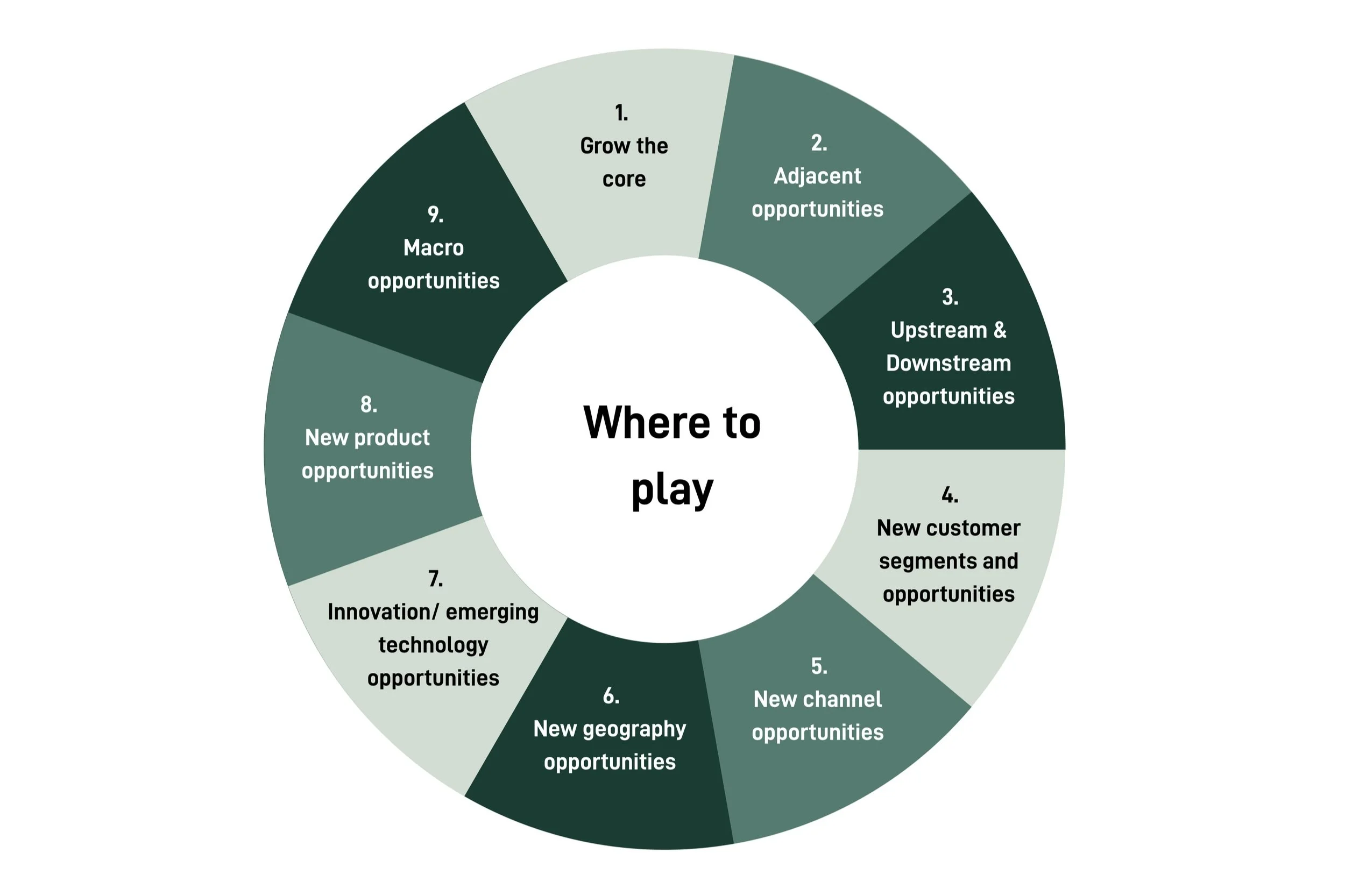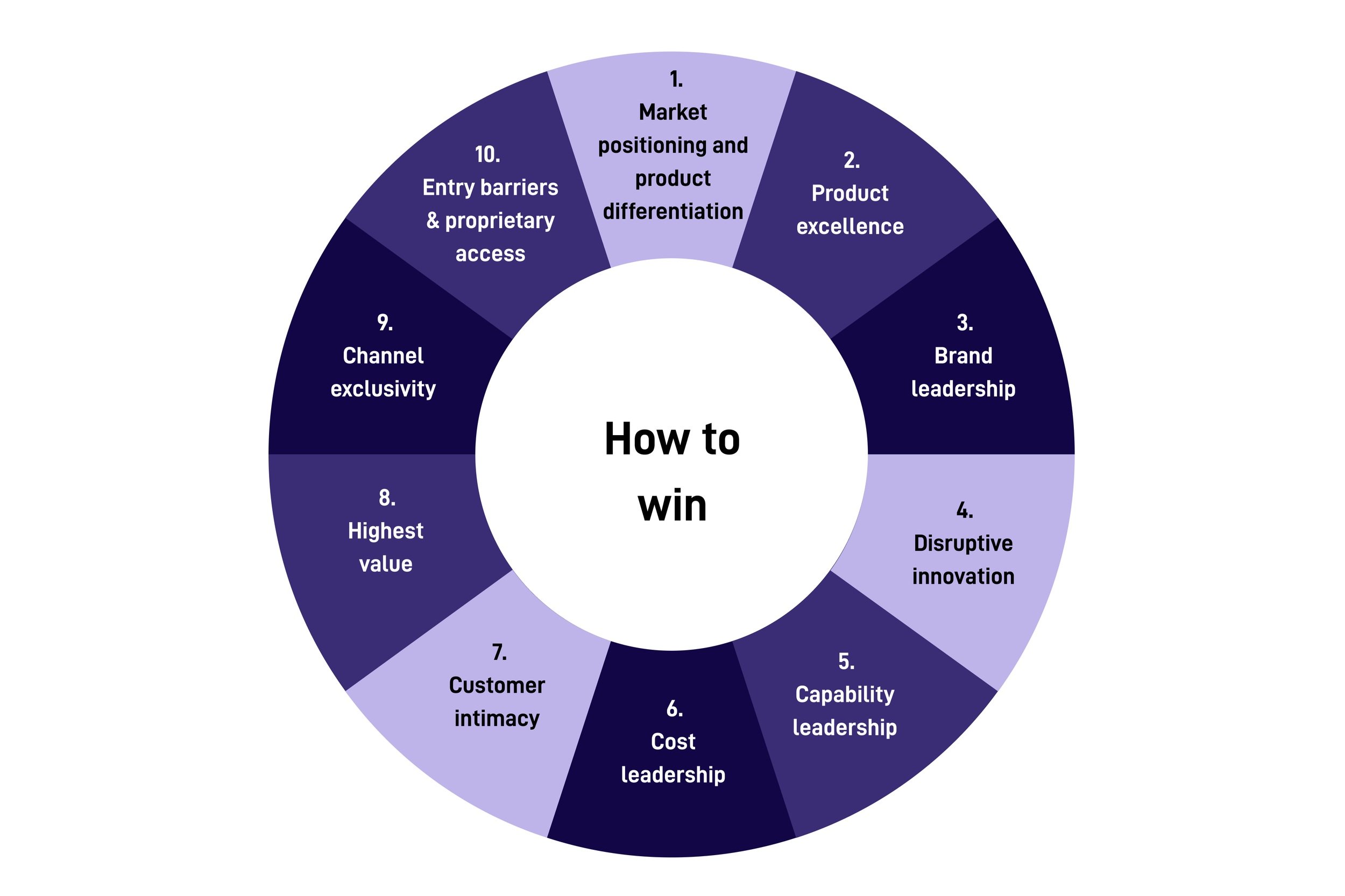Growth Strategy 101 Series: Where to Play & How to Win
What's a Growth Strategy? Growth strategy is the strategic initiatives a company pursues to create more value for the organization and its stakeholders and gain a continued competitive advantage in the market. A solid strategy is crucial to a company's success and regular reviews ensures organisations don’t miss opportunities to further expand and grow.
Strategy can be difficult to define, but essentially it can be thought of as: "Determining how we will win in the period ahead." We unpack this into two key questions to solve for:
Where to play: Looking at our current business, capabilities, customer base, and the market trends (competition, industry trends, innovation), where are we uniquely well qualified to play?
How to win: How will we gain and maintain a competitive advantage in the market, win and retain customers in a profitable way?
The process of determining "where to play" is a critical component of strategic planning. It involves a comprehensive analysis of both internal and external factors to make informed decisions that will guide the allocation of resources and the pursuit of your organization's future strategic goals.
There are a few strategic frameworks to consider for analysing the ‘Where to Play’, like Porter’s Five Forces (looking at Competitive Rivalry, Supplier Power, Buyer Power, Threat of Substitution, and Threat of New Entry), The Strategy Matrix (looking at market growth & competition), SWOT analysis (Probably more used in the ‘How to win’ part of strategy) and a few others.
At Tightrope, we use a mix of these models to ensure we do a broad discovery of the growth opportunity space (‘where to play”). Typically, we do research to answer the following 9 questions and identify where the next horizon of growth will come from:
Grow the Core - Unlock trapped growth potential: Before looking at new growth, we focus on identifying growth within the existing value propositions, in the current market, for the current customer segments. This usually results in opportunities to improve Marketing & Sales, improve the service/product features, tweak the business model or pricing strategy, improve customer experience & service, and push further GTM partnerships to accelerate growth. The goal is to further gain competitive advantage in our core business.
Adjacent opportunities: Are there other unmet customer needs or pain points that can be met by the clients’ services or products, or additional customer needs the business can easily solve with the unique expertise present in the organisation?
Upstream & Downstream opportunities: Are there opportunities to take up activities upstream or downstream from the current product proposition? For example, upstream could be taking parts of production in house, downstream could be taking more control of distribution.
New customer segments opportunities: Looking at the existing customers, can we reach other customer segments by making small changes to our proposition or business model? Are there other customer segments that would benefit from our services or products?
New channel opportunities: Can we reach more customers through new or different channels? How do we build up presence closer to our audience?
New geography opportunities: Are there opportunities to export our services to new regions and new markets. How can we move from local operations, to national and to global operation.
Innovation / Emerging Technology opportunities: How are emerging technologies impacting our products or services? Are there opportunities to drastically change what we do enabled by innovation? (can be tech innovation, business model innovation, etc)
New product opportunities: Are there logical product diversification opportunities where we have a right to play because we understand the customer, understand the industry, have the right expertise & capabilities, etc?
Macro Opportunities: How can we anticipate the impact of macro trends including economic trends, regulatory or legal changes, socio political events, etc to not disrupt our business but be opportunities for growth?
When considering these opportunities, it’s important to overlay the strategic fit of the opportunities to the organisation’s overall mission, review the ability to attribute the right resources to go after the opportunities and properly prioritise opportunities against the growth potential and risks associated with going after them.
Once we have a clear understanding of the different opportunity areas (‘Where to Play’), the focus shifts to developing the right strategy that will see the client be well positioned to succeed in executing. The ‘How to win’ is equally important to knowing where to play as without the proper strategy or plan, the chances of a successful outcome are slim. The ‘How to Win’ articulates how we will differentiate ourselves from competition and ensure we can gain and protect market share.
There are 10 strategies to have a unique position in the market:
Market positioning & Product Differentiation: Have a unique proposition, not easy to replicate, solving customer needs in a differentiated way.
Product Excellence: Have the best product / service out there.
Brand Leadership: Have the most recognised product, driving awareness through great branding and marketing.
Disruptive Innovation: Solve a customer way in an innovative or disruptive way, unlike the way it is done traditionally.
Capability Leadership: Do something others can’t because they don’t have the capability maturity to compete.
Cost Leadership: Deliver a service or product in the most cost-effective way, being able to compete on price.
Customer Intimacy: Deliver the best customer experience, providing very customised services that meet the needs of individual customers.
Highest Value: Solving a problem in the most comprehensive way, delivering end to end solutions for customers that justify a premium.
Channel Exclusivity: Create exclusive partnerships, exclusive distribution channels that give you protected access to markets or customer segments.
Entry Barriers or Proprietary Access: Put barriers of entry in place so that your product or service becomes the de-facto way to buy products or services.
In defining the ‘How to Win’ it’s clear that some trade-offs need to be made (it’s hard to be the cost leader AND the product excellence leader), most organisations will again combine a few of the above to deliver a unique and compelling proposition. Market leaders like Apple for example aim to deliver disruptive innovation to deliver market leading product, combined with amazing customer experience and branding resulting in a very loyal customer base which is hard to disrupt.
Defining a "how to win" strategy is an ongoing process that requires careful planning, execution, and adaptation. It should be flexible enough to respond to changes in the business environment and industry dynamics while remaining aligned with your organization's long-term objectives.
Knowing “How to Win” is of course only the starting point towards successful execution of the strategy. It needs to align to the long-term vision and goals of the organisation and the operational mechanisms need to be in place to execute the strategy. A few key success factors to execute the “how to win” are:
Right Leadership and Culture: Foster a culture that supports your "how to win" strategy. Leadership should set the tone for the organization's commitment to the strategy.
Fast Feedback and Adaptation: Collect feedback from customers, employees, and stakeholders to make necessary adjustments to your strategy.
Measurable Goals and Key Performance Indicators (KPIs): Define specific, measurable goals and KPIs to track your progress and success in executing the strategy.
Proper Resource Allocation: Allocate resources, including budget and human resources, according to the strategic priorities defined in your "how to win" plan.
Sufficient Communication and Alignment: Ensure that all members of the organization understand and are aligned with the "how to win" strategy. Regularly communicate the strategy throughout the organization.
Rigorous Execution and Monitoring: Implement the strategy effectively and continuously monitor its progress. Be prepared to adapt and iterate as market conditions and opportunities change.
We’ll dive deeper into some of the individual strategies and key execution success factors in subsequent posts. Please reach out if you want to know more about how we help clients define successful growth strategies.


